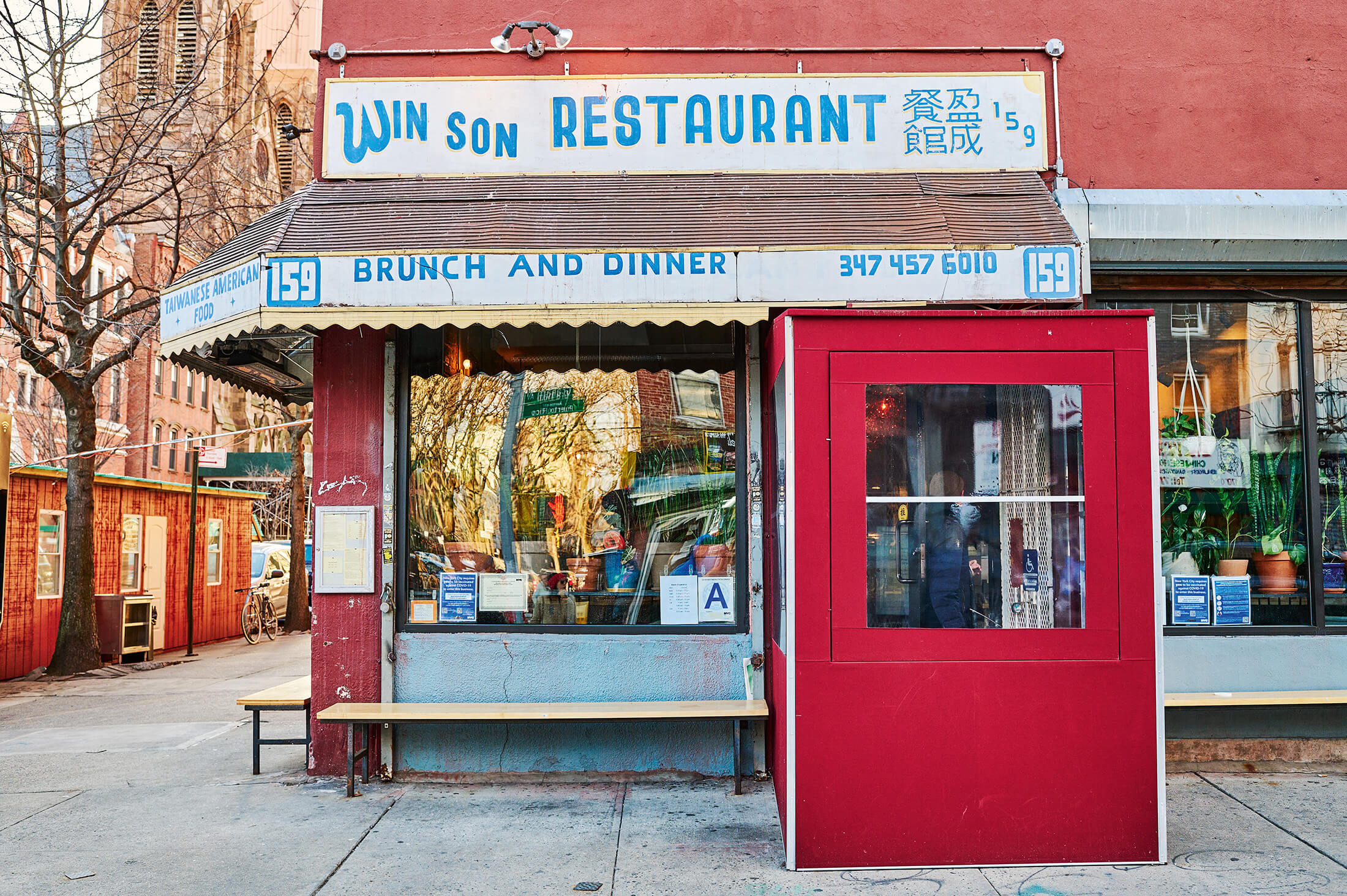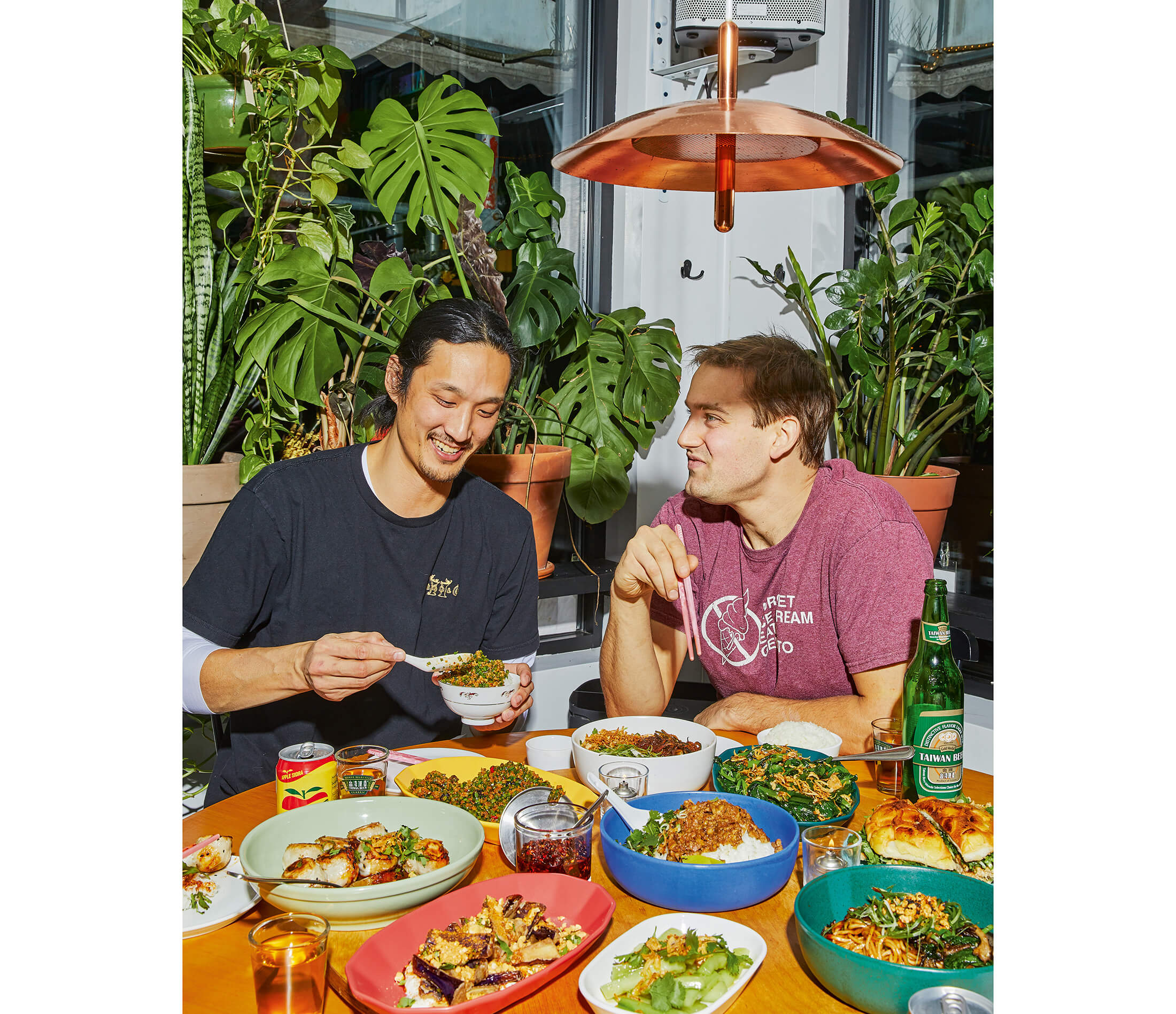Food for Friends: Win Son's Founders Dish on the Importance of Chasing Your Dreams
A somewhat unlikely Taiwanese-American eatery in Williamsburg, a labor of love bootstrapped by two fledgling restaurateurs, has taken off – so much so that the prime minister of Taiwan recently visited.

The Win Son team. Photo by Laura Murray
A somewhat unlikely Taiwanese-American eatery in Williamsburg, a labor of love bootstrapped by two fledgling restaurateurs, has taken off – so much so that the prime minister of Taiwan recently visited. A place to try new flavors and inventive combinations, with a charming DIY interior and old-fashioned sign, Win Son is not strictly traditional but the food is fun, flavorful, and approachable.
Founders Trigg Brown and Josh Ku, two New Yorkers with diverse backgrounds – one had worked in restaurants, the other in real estate – brought their take on Taiwanese food to Graham Avenue/Avenue of Puerto Rico in 2016, then opened cafe and bakery Win Son Bakery across the street in 2019.
A cookbook co-authored with Cathy Erway, “Win Son Presents a Taiwanese American Cookbook,” followed earlier this year. In it, they share their spin on Taiwanese-American food and culture and give a behind-the-scenes view of their enterprise, partnership, and relationship to Taiwan.
Brown, a chef, and Ku, in property management, discovered their shared affinity for hard work, Taiwanese food, and looking after their friends when they met at a backyard barbecue in Bed Stuy in 2012. As the months passed, Ku shared his Taiwanese heritage with Brown, who has worked at prominent restaurants including Colicchio & Sons, Craft, and Upland.

How did you meet?
Ku: One of my best friends lived above Trigg and his roommates. Around that time, I was working as a property manager, and I was tired of the job. It was pretty much being on call 24/7.
Is a restaurant much different?
Brown: Josh and I both, we’re down to work and be on call 24/7, but we wanted to do it with a more meaningful purpose.
Why did you open the restaurant?
Brown: We always fantasized about having an eight-item menu, a simple, affordable restaurant. We loved restaurants like Num Pang, Momofuku. I really knew what kind of food inspired me and what I liked to do. Let’s keep it simple. We went to Taiwan, and we connected with the culture, and our friendship was built on Taiwanese food.
How did you choose the location? And how did it inform the menu and design of the restaurant?
Ku: So that space, actually, I was preparing to rent and at the end of the day, I found myself kind of feeling protective over it. One of my favorite restaurants at the time was a place called Faro, opened by Kevin Adey, who was the chef at Northeast Kingdom, and that was the first restaurant I had been introduced to when hanging out in Bushwick. The way he laid out his restaurant was in three rows. Seeing Faro and the way they laid out their restaurant, I mimicked that with the layout and did yin and yang banquettes to create wall space, but then also encompass some cozy feeling, but also just very simple. The hardwood floor that’s there was original to the building and I just put sub flooring and some vinyl tile on the other bits. The buildout was very DIY and we’ve since spent a lot of money on improving the equipment and the layout of the space. One of the things that we’re really blessed with, being in that area specifically, is the sheer amount of Chinese and Taiwanese vendors, whether they’re restaurant supply companies or dry goods companies.
You have had very diverse food experiences and a lot of creativity mixed in there from mentors. What does Taiwanese-American mean to both of you?
Brown: [Here’s] an example. So at the time, there was this crazy weird moment in food, it was fried chicken year. Everybody was like I have the best chicken sandwich, including us line cooks at Craft making the family meal. So I was really into fried chicken sandwiches, just like every other chef was at the time. I think at this point, Josh is building out the restaurant and I was kind of coming to terms with the way service is going to play out, and the whole time we knew we wanted to do a fried chicken sandwich. It is common knowledge among food people or people who try to educate themselves about other cultures’ cuisines that fried chicken with cayenne pepper, five spice, and white pepper, that Taiwan has a good reputation for that. So I was like, this is perfect, let’s meld like southern fried chicken and Chinese big fried chicken and let’s use that. Josh explained to me that he grew up in his church community and they would often bring fried chicken on bolo bao. I was like, oh my god, thank you. You just made our fried chicken sandwich what it is.

What are the pantry staples that you have at your own home?
Ku: I don’t cook this much. But our friend Lisa [Cheng Smith] has this Taiwanese pantry where she imports a lot of dry goods from Taiwan. She has a firewood soybean paste I really love to use with anything, my girlfriend loves to use that. But in terms of more specific Taiwanese pantry items, maybe the rice wine that we get, anything that goes into a Flies’ Head basically.
Brown: I used to not cook at home ever because I was at work all the time. I have kids now and I think I almost cook more at home now for the first time in my life. Front and center of that, I love Lisa’s firewood bean paste, like Josh said, it’s amazing. You put it on blanched vegetables or toss it in a stir fry, or make a vinaigrette, it’s just like an incredible glaze-y, sweet, salty, it’s the perfect seasoning agent. We also make some sauces at the restaurant. There’s a mustard green, ginger, scallion condiment, I usually always have a cup of it. It’s great for marinating fish. Everybody should make that at home and have that always in their house because it’ll last like a week or two. It’s great on raw fish. It just changes the game. My wife, she’s Korean, well she’s from Texas but she grew up in Korea, so I have this weird Taiwanese, Korean, Italian pantry and I can’t get away from any of those ingredients. So Lisa’s firewood bean paste, gochugaru, nice salt and pepper, nice olive oil, a nice sesame oil, Lisa offers a peanut oil. Having an array of oils and knowing when to use them. That kind of technique and skill, I think is worth it. One thesis about our book is like go to the Asian market, go to the Chinese market and start off with some nice ingredients. And then once you familiarize yourself with these ingredients, keep your eyes peeled for Lisa’s products because she’s changing the game.
Do you have some favorite spots and what do you like to do in your time off?
Brown: When I’m at the restaurant late these days or if I go see the Nets play I like to go over to Josh’s new spot, Chino Grande, and sing some karaoke. That’s fun. I love to go to my buddy Jake Leiber and his partner Aidan O’Neal’s restaurant Chez Ma Tante. And I like getting some breakfast at that old double horseshoe bar, Peter Pan Donut, and the tea store in Greenpoint, Kettl.
Ku: Lately I’ve been going to Fan Fried Rice Bar, which just moved from Bed Stuy to Williamsburg really close to Chino’s, and they’re always great for a quick lunch. I like this other conveniently located restaurant with very decent food for the area, Taste Korea 232. Their Galbi-tang is really great and has carried me through many sicknesses. And I love pasta, so Carmenta’s, that’s our friend’s restaurant, and Forma Pasta.
Brown: I’ve got to jump in real quick, one thing that we are both deeply passionate about, that we don’t get to do much anymore, it happens about once a year, is we love bicycles. Biking together is a really fun thing to do. We’ve done that a couple of times when the weather’s nice. That kind of takes us back to when we first became friends. Brooklyn is terrible logistically, right? If you don’t have a bike, you can’t really get out of north Brooklyn or go into the city. It just kind of makes the world a smaller place. In the summer, it’s really cool on a bike, it’s easy. There’s just this way of seeing Brooklyn on a bike that if you don’t do that, then you’re missing out.
Ku: You’re literally from L.A.
Brown: [Laughs] Also I have got to shout out to my buddy Mike [Fadem] from Ops, that restaurant is one of my all time favorite restaurants, I think it’s some of the best pizza in the country and I think it has one of the best wine lists in the country. I take all of my family and friends there.

What do you want people to take away from the book?
Brown: I guess ultimately, I’m just super grateful for the opportunity to see this photo album with these stories and, like Josh was saying, we’re just blessed to work with all these people and what the book really does well is communicate that passion for collaboration and supporting each other and our friends that Josh and I really authentically have, and I think the book says that and speaks for itself. From a cook’s perspective, like I said, it’s go to the Asian market and get some ingredients, and then keep your eyes peeled for people like Lisa. I think when you see people wake up to certain baseline ingredients in other cultures and start folding that in, you learn and your awareness is heightened.
Ku: I think, you know, what Trigg said is the most practical thing, but I think something that people can recognize, in any industry, our story is kind of one where we took a leap of faith, a risk for an opportunity that we felt was there. We were more or less ready for it. I feel like a lot of people, peers of ours or just folks that we work with, they see the story or they talk to us about that. There are so many talented people out there in New York and it’s easy to get caught up where you’re at in the industry you’re in, and it’s kind of hard to see things after a while outside of that, and you’re informed by your education, you’re informed by your friends and your parents, whatever pressures you’re dealing with. I think especially for Asian Americans, to a certain extent, it’s a difficult thing to follow your passion. I think it’s getting more and more accessible and people can find more of their heroes, but it’s still a challenge. It’s just as risky as it was when we were doing it and it’s just knowing when to take that leap and being ready, as ready as you can. I hope people take away that support from the book.
Editor’s note: A version of this story appeared in the Spring/Summer 2023 issue of Brownstoner magazine.
Related Stories
- Prospect Heights Food Writer Melissa Clark Explains How One-Pot Meals Are Like Haiku
- Duo Behind Bushwick’s Astrology-Themed Bar Mood Ring Serve Up Tips, Stories, Recipes
- For Fort Greene Chef and Author Carla Lalli Music, Food Creates Family
Email tips@brownstoner.com with further comments, questions or tips. Follow Brownstoner on Twitter and Instagram, and like us on Facebook.









What's Your Take? Leave a Comment